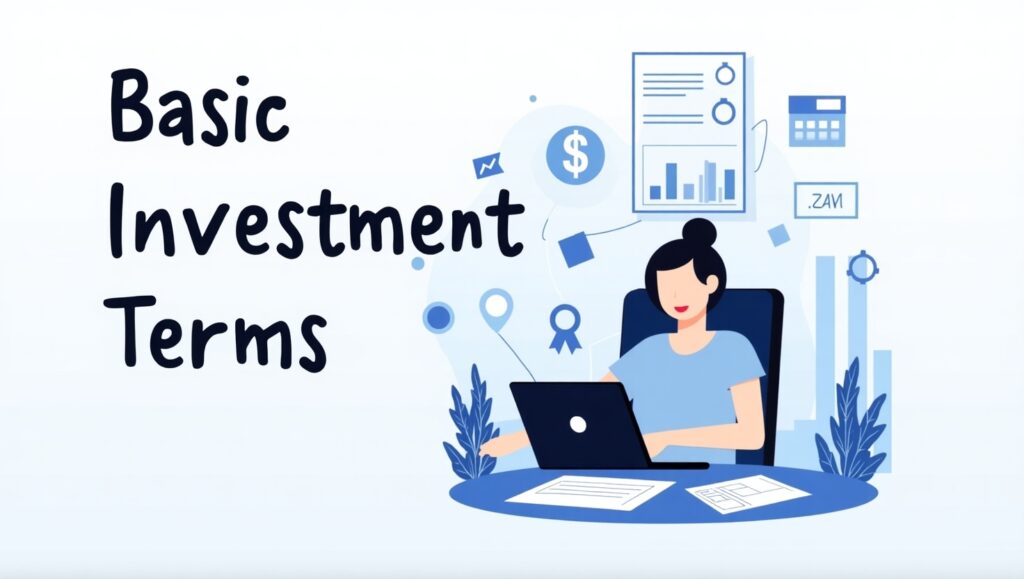Disclaimer: The information provided in this article is for educational purposes only and should not be considered as financial advice. I am not a licensed financial advisor or consultant. All opinions shared here are based on my personal research and learning journey. Please consult with a qualified financial professional before making investment decisions that could affect your financial situation.
Starting your investment journey can feel overwhelming, especially when you’re bombarded with industry jargon that sounds like a foreign language. The truth is, 47% of US adults continue to give their personal finance knowledge a grade of “C” or worse, according to the National Foundation for Credit Counseling’s 2024 Financial Literacy Survey.
However, understanding these fundamental investing terms isn’t just about sounding smart at dinner parties. It’s about building the confidence and knowledge you need to make informed decisions about your financial future. Moreover, studies show that only 33% of adults globally are financially literate, which means mastering these basics puts you ahead of the majority.
Related Reading: For a deeper understanding of why financial literacy matters, check out this comprehensive guide on building wealth through smart investing strategies.
Quick Reference: Essential Investing Terms at a Glance
Before we dive deep into each term, here’s a quick overview of the 8 essential investing terms that will transform your understanding of the financial world:
- Stocks (Equities): Ownership shares in companies
- Bonds: Loans you give to governments or corporations
- Mutual Funds: Professionally managed investment pools
- ETFs: Exchange-traded funds that track indexes
- Diversification: Spreading investments to reduce risk
- Risk Tolerance: Your comfort level with potential losses
- Compound Interest: Earning returns on your returns
- Dollar-Cost Averaging: Regular investing regardless of market conditions
Furthermore, these terms form the foundation of every successful investment strategy. Once you understand them, you’ll find that reading financial news, analyzing investment opportunities, and making portfolio decisions becomes significantly easier.
Why Understanding Investment Terminology Matters More Than Ever
The investing landscape has never been more accessible to ordinary people like you and me. Thanks to technology, commission-free trading platforms, and educational resources, we can now build investment portfolios with just a few clicks. Nevertheless, this accessibility comes with responsibility—the responsibility to understand what we’re investing in.
Additionally, the cost of financial illiteracy is real and measurable. According to the National Financial Educators Council, financial illiteracy costs Americans an average of $1,015 annually. That’s money that could be working for you in the market instead of being lost to poor financial decisions.
The 8 Essential Investing Terms You Need to Master
1. Stocks (Equities): Your Slice of Company Ownership
When someone talks about “buying stocks,” they’re referring to purchasing shares of ownership in publicly traded companies. Think of stocks as tiny pieces of a company that you can own. For instance, when you buy Apple stock, you become a partial owner of Apple Inc., entitled to a portion of its profits and voting rights on certain company matters.
Key Points About Stocks:
- Represent ownership in companies
- Prices fluctuate based on company performance and market sentiment
- Can provide returns through price appreciation and dividends
- Generally considered higher risk but offer higher potential returns
Actionable Tip: Start by researching companies you understand and use daily. If you love Starbucks coffee and believe in their business model, consider researching their stock (SBUX) using free tools like Yahoo Finance or Google Finance.
2. Bonds: The Steady Income Generators
Bonds are essentially IOUs. When you purchase a bond, you’re lending money to a government or corporation in exchange for regular interest payments and the return of your principal when the bond matures. While bonds typically offer lower returns than stocks, they’re generally considered safer investments.
Types of Bonds:
- Government bonds (like U.S. Treasury bonds)
- Corporate bonds (issued by companies)
- Municipal bonds (issued by local governments)
Why Bonds Matter: Bonds provide stability to your portfolio and generate predictable income. They often move in the opposite direction of stocks, which helps balance your overall investment risk.
Pro Tip: Consider using Treasury Direct to purchase government bonds directly, avoiding broker fees while supporting your portfolio’s stability.
3. Mutual Funds: Professional Management Made Simple
Mutual funds pool money from thousands of investors to purchase a diversified portfolio of stocks, bonds, or other securities. Professional fund managers make the investment decisions, which is particularly helpful for beginners who don’t have the time or expertise to research individual investments.
Benefits of Mutual Funds:
- Professional management
- Instant diversification
- Lower minimum investment requirements
- Automatic reinvestment options
Considerations:
- Management fees (expense ratios) can eat into returns
- Less control over individual holdings
- Potential tax inefficiencies
Action Step: Research low-cost mutual funds through platforms like Vanguard or Fidelity, focusing on funds with expense ratios below 0.5%.
4. ETFs (Exchange-Traded Funds): The Best of Both Worlds
ETFs combine the diversification benefits of mutual funds with the trading flexibility of individual stocks. These funds track indexes, commodities, bonds, or baskets of assets, and trade on stock exchanges throughout the day.
ETF Advantages:
- Lower expense ratios than most mutual funds
- Trade like stocks during market hours
- Tax efficiency
- Transparency in holdings
Popular ETF Categories:
- S&P 500 ETFs (like SPY or VOO)
- Total Stock Market ETFs (like VTI)
- International ETFs (like VTIAX)
- Bond ETFs (like BND)
5. Diversification: Don’t Put All Your Eggs in One Basket
Diversification is the practice of spreading your investments across different asset classes, industries, and geographic regions to reduce risk. The idea is that when some investments perform poorly, others may perform well, balancing out your overall returns.
Types of Diversification:
- Asset class diversification (stocks, bonds, real estate)
- Geographic diversification (domestic and international)
- Sector diversification (technology, healthcare, finance)
- Time diversification (investing regularly over time)
Real-World Example: Instead of putting all your money in tech stocks, you might invest 60% in stocks (across various sectors), 30% in bonds, and 10% in real estate investment trusts (REITs).
6. Risk Tolerance: Know Yourself Before You Invest
Risk tolerance refers to your ability and willingness to lose some or all of your original investment in exchange for greater potential returns. Your risk tolerance should guide your investment choices and portfolio allocation.
Factors Affecting Risk Tolerance:
- Age and time horizon
- Financial situation and income stability
- Investment goals
- Personal comfort with volatility
Assessment Questions:
- How would you react if your portfolio lost 20% in a month?
- When do you need access to your invested money?
- What’s more important: preserving capital or growing wealth?
Helpful Tool: Many brokerages offer free risk tolerance questionnaires. Platforms like Charles Schwab and TD Ameritrade provide comprehensive assessments to help determine your investor profile.
7. Compound Interest: The Eighth Wonder of the World
Compound interest is the process of earning returns not just on your original investment, but also on the returns you’ve already earned. Albert Einstein allegedly called it “the eighth wonder of the world,” and for good reason—it’s the secret to long-term wealth building.
How Compound Interest Works:
- Year 1: Invest $1,000, earn 7% = $1,070
- Year 2: Earn 7% on $1,070 = $1,144.90
- Year 3: Earn 7% on $1,144.90 = $1,225.04
The Power of Time: Starting early makes a massive difference. Someone who invests $200 monthly starting at age 25 will have significantly more at retirement than someone who starts at 35, even if the later starter invests more each month.
Calculation Tool: Use compound interest calculators like the one at Investor.gov to see how your investments could grow over time.
8. Dollar-Cost Averaging: Taking Emotion Out of Investing
Dollar-cost averaging (DCA) involves investing a fixed amount of money at regular intervals, regardless of market conditions. This strategy helps reduce the impact of market volatility and removes the pressure of trying to time the market.
Benefits of Dollar-Cost Averaging:
- Reduces average cost per share over time
- Eliminates the need to time the market
- Builds disciplined investing habits
- Reduces emotional decision-making
Example: Instead of investing $1,200 all at once, you invest $100 every month for 12 months. Some months you’ll buy more shares (when prices are low), some months fewer (when prices are high), but over time your average cost will likely be favorable.
Implementation: Most brokerages offer automatic investment plans. Set up recurring investments through platforms like Robinhood, Fidelity, or Vanguard to make dollar-cost averaging effortless.
How These Terms Connect: Building Your Investment Strategy
Understanding these terms individually is important, but seeing how they work together is where the magic happens. Here’s how a beginner might apply all these concepts:
Sample Beginner Portfolio Strategy:
- Assess your risk tolerance using online tools
- Choose diversification across stocks, bonds, and international investments
- Select low-cost ETFs for broad market exposure
- Implement dollar-cost averaging by investing monthly
- Leverage compound interest by reinvesting dividends and staying invested long-term
Furthermore, this integrated approach addresses the common mistake of focusing on individual stock picks instead of building a well-rounded portfolio. By understanding how these terms interconnect, you’ll make more informed decisions that align with your financial goals.
Common Mistakes to Avoid When Learning Investment Terminology
As I’ve learned through my own journey and countless hours of research, beginners often make predictable mistakes when first encountering investment terminology:
Mistake 1: Confusing Stocks and Stock Funds Many beginners think buying individual stocks is the same as investing in stock mutual funds or ETFs. While both involve stocks, the risk and diversification profiles are completely different.
Mistake 2: Ignoring Expense Ratios Not all mutual funds and ETFs are created equal. A fund with a 1.5% expense ratio will cost you significantly more over time than one with a 0.1% expense ratio, even if their performance is similar.
Mistake 3: Misunderstanding Risk Tolerance Young investors often think they should only invest in bonds because they’re “safer,” while older investors sometimes chase risky investments for higher returns. Your risk tolerance should align with your timeline and financial situation, not just your age.
Taking Action: Your Next Steps
Now that you understand these essential investing terms, it’s time to put this knowledge into practice. Here’s your action plan:
Immediate Actions (This Week):
- Open a brokerage account with a reputable firm like Fidelity or Vanguard
- Complete a risk tolerance assessment
- Research one broad-market ETF (like VTI or VOO)
Short-term Actions (This Month):
- Start dollar-cost averaging with a small amount ($50-100 monthly)
- Read one investing book (I recommend “A Random Walk Down Wall Street” by Burton Malkiel)
- Subscribe to financial podcasts like “The Investors Podcast” or “Motley Fool Money”
Long-term Actions (Next 3 Months):
- Gradually increase your monthly investments
- Learn about tax-advantaged accounts (401k, IRA)
- Consider working with a fee-only financial advisor
Frequently Asked Questions
What’s the difference between stocks and bonds in simple terms?
Stocks represent ownership in companies—when you buy stock, you own a piece of that business. Bonds are loans—when you buy a bond, you’re lending money to a government or company that pays you interest. Stocks typically offer higher potential returns but more risk, while bonds provide steadier, lower returns with less risk.
How much should a beginner invest to get started?
You can start investing with as little as $1 thanks to fractional shares offered by many brokerages. However, I recommend starting with an amount you can consistently invest monthly, whether that’s $25, $100, or $500. The key is consistency rather than the initial amount.
Are ETFs better than mutual funds for beginners?
Both can be excellent choices for beginners. ETFs typically have lower expense ratios and more trading flexibility, while mutual funds might offer more hand-holding and automatic features. The most important factor is choosing low-cost options that match your investment goals, regardless of whether they’re ETFs or mutual funds.
How do I know if I’m being too risky or too conservative with my investments?
Your investment allocation should primarily depend on your time horizon and financial goals. A general rule of thumb is to subtract your age from 110 to determine your stock allocation percentage. For example, a 30-year-old might consider 80% stocks and 20% bonds. However, your personal financial situation, risk tolerance, and goals should ultimately guide these decisions.
Should I try to time the market or just invest regularly?
For beginners (and most experienced investors), dollar-cost averaging—investing regularly regardless of market conditions—is typically more effective than trying to time the market. Even professional fund managers struggle to consistently time the market successfully. Focus on time in the market rather than timing the market.
Conclusion: Your Journey to Financial Literacy Starts Now
Mastering these eight essential investing terms isn’t just about expanding your vocabulary—it’s about building the foundation for your financial future. Throughout my own learning journey, I’ve discovered that understanding these basics has given me the confidence to make informed investment decisions and avoid costly mistakes.
Remember, investing is a marathon, not a sprint. The compound interest that seems insignificant today will become your greatest ally over time. Start small, stay consistent, and keep learning. Every successful investor started exactly where you are now—with curiosity, determination, and a willingness to learn.
The path to financial freedom isn’t reserved for Wall Street professionals or people with advanced degrees in finance. It’s available to anyone willing to educate themselves and take consistent action. By understanding these fundamental terms and applying them to your investment strategy, you’re already ahead of the majority of Americans who lack basic financial literacy.
Your future self will thank you for taking this first step today.


